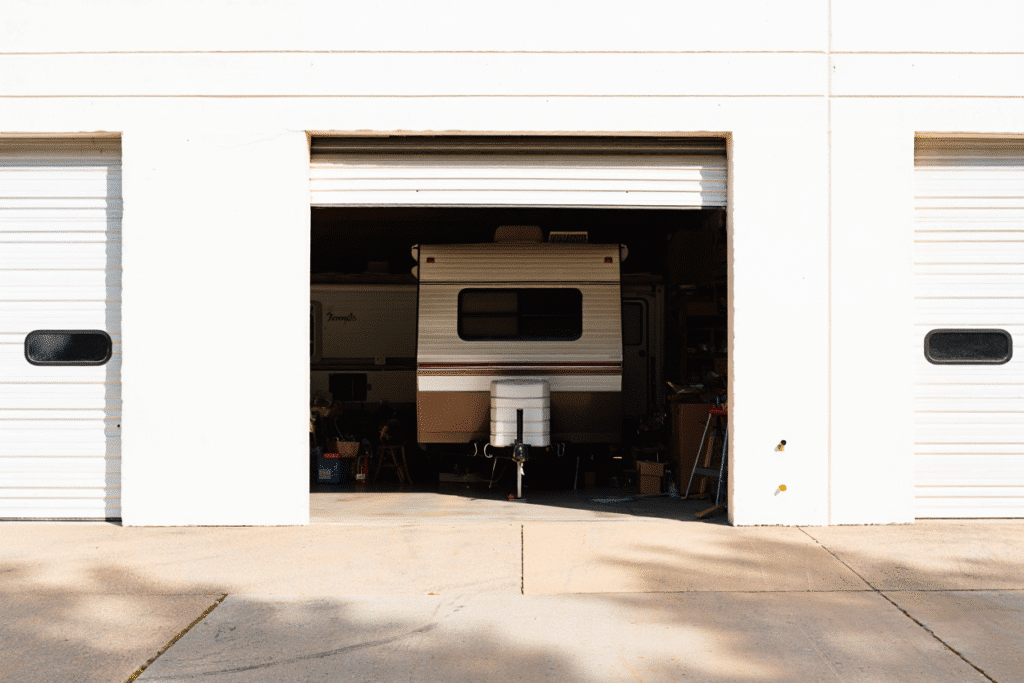Choosing the right dimensions is crucial to guarantee a new garage door not only looks good but also works well. If you’re putting in a new door or have an old one that needs replacing, knowing the standard garage door sizes helps you grasp the range of options available to you. That understanding, in turn, aids you in making a choice that’s not just functionally sound but also in keeping with the design of your home.
Most houses have garages that conform to standard dimensions, with two basic types of garage doors: single-car and double-car. A single-car garage door ranges in width from 8 to 10 feet, and a double-car door from 16 to 20 feet. Most of the time, these doors are around 7 to 8 feet tall. But, as we know, many houses either don’t have garages or have garages that just don’t fit these basic types, with any number of odd and even dimensions, and with any number of weird configurations that could fit a garage.
Standard Garage Door Sizes and Prices
Standard garage door sizes are designed to meet the majority of residential requirements, while custom options are available to address specific needs. Costs depend on factors such as size, materials, and installation details.
1. Single Car Garage Doors
Single-car garage doors range from 8 to 10 feet in width and 7 to 8 feet in height. The 9×7 configuration remains the most popular choice, fitting sedans, crossovers, and compact SUVs comfortably.

Common single-car door dimensions and typical price ranges:
| Size (Width x Height) | Price Range* | Best For |
| 8 x 7 feet | $400-$1,200 | Small cars, tight spaces |
| 9 x 7 feet | $450-$1,400 | Standard vehicles |
| 9 x 8 feet | $500-$1,600 | Taller vehicles, SUVs |
| 10 x 7 feet | $550-$1,800 | Larger trucks, extra clearance |
*Prices vary by material: steel, aluminum, wood, or composite
2. Double Car Garage Doors
Double-car garage doors typically range in dimensions from 12 to 20 feet in width and 7 to 8 feet in height. The most common standard size for a two-car garage is 16 feet wide by 7 feet tall.

Standard double-car door specifications and pricing:
| Size (Width x Height) | Price Range* | Vehicle Capacity |
| 12 x 7 feet | $600-$2,000 | Two compact cars |
| 14 x 7 feet | $700-$2,200 | Two midsize vehicles |
| 16 x 7 feet | $800-$2,500 | Two standard vehicles |
| 18 x 7 feet | $900-$3,000 | Two large SUVs/trucks |
*Installation costs add $200-$800, depending on complexity
3. RV Garage Doors
RV garage doors are specifically designed to accommodate recreational vehicles, boats, and trailers, typically measuring between 10 to 14 feet in width and 12 to 16 feet in height. These larger doors are built with reinforced tracks and heavy-duty springs to ensure durability and performance.

RV door configurations and associated costs:
| Size (Width x Height) | Price Range* | Suitable For |
| 10 x 12 feet | $1,500-$3,500 | Small RVs, boats |
| 12 x 14 feet | $2,000-$4,500 | Standard RVs, large trucks |
| 14 x 14 feet | $2,500-$5,500 | Class A RVs, buses |
| 14 x 16 feet | $3,000-$6,500 | RVs with roof accessories |
*Includes heavy-duty hardware and reinforcement.
4. Custom Garage Doors
Custom garage doors are specifically designed to fit non-standard openings and meet unique design needs. These doors are manufactured with precise measurements, supporting widths of up to 40 feet and heights over 16 feet.

Custom door pricing factors include:
- Non-standard dimensions increase costs by 20-50%
- Specialty materials (glass panels, exotic woods) add $500-$3,000
- Unique hardware requirements cost $200-$1,000 extra
- Extended manufacturing time affects delivery (4-12 weeks)
Commercial applications, historic renovations, and luxury homes often require custom solutions. These doors integrate specific architectural elements while maintaining proper functionality and safety standards.
How to Measure the Garage Door Size
Step 1: Measure the Rough Opening
Use a steel tape measure to find the dimensions of the garage door opening. You need to know the width and height of the rough opening. The width is from the inside edge of the left jamb to the inside edge of the right jamb. The height is from the floor to the bottom of the header board. And make sure you know these measurements accurately, especially if you’re working in an older garage. Your rough opening dimensions should match the door dimensions.
Step 2: Side Room
Side room is the space on either side of the garage door opening, needed for vertical track installation. It requires at least 3.75 inches per side, though 5.5 inches is preferable for double-car doors. For an automatic opener, you’ll need at least 10 inches on the motor side. Make sure there are no obstructions like pipes or electrical panels.
Step 3: Headroom
Headroom is the space between the top of the garage door opening and the ceiling or any obstruction. Standard garage doors need at least 12 inches, but 15 inches is better for automatic openers. If space is tight, low-headroom tracks needing only 4.5 inches are an option, though they often cost more and may need professional installation.
Step 4: Backroom
Backroom is the space from the garage door opening to the back wall or any obstruction, required for the door to fully open. Sectional doors need a backroom depth equal to the door height plus 18 inches (e.g., a 7-foot door needs 8.5 feet). Measure straight back, ensuring no obstructions like shelves or vehicles interfere. For limited backroom, consider high-lift or vertical-lift doors.
What to Consider When Choosing a Garage Door
Selecting the right size for a garage door requires careful thought about factors that go beyond standard dimensions. This choice is pivotal not just for making sure that cars can get in and out, but also for maximizing the overhead of the garage and, in the long run, the value of the property.
1. Garage Dimensions
Proper measurements are crucial for selecting and installing garage doors. Measure the width and height of the opening, ensuring at least 12 inches of headroom (15 inches for automatic openers). Also, check for side clearance, which should be 3.75 inches for sectional doors and 5.5 inches for roll-up doors. Be aware of overhead obstructions, such as pipes or ducts.
2. Vehicle Size
Choose a garage door size based on your largest vehicle and necessary clearance. Sedans fit well with 8×7 doors, offering 12-18 inches of clearance. Pickup trucks and SUVs need 9×7 or 10×8 doors, while extended cab trucks with towing mirrors require at least 10 feet in width. RVs and trailers may need specialized doors: Class B motorhomes use 10×12 doors, and Class A motorhomes typically need 12×14 or larger. Consider roof accessories like bike racks or cargo boxes when deciding door height.
| Vehicle Type | Minimum Width | Minimum Height |
| Sedans | 8 feet | 7 feet |
| Full-Size Trucks | 9 feet | 8 feet |
| Large SUVs | 10 feet | 8 feet |
| RVs/Motorhomes | 12 feet | 12 feet |
3. Storage Needs
When choosing garage door sizes, consider storage needs for functionality. Wall-mounted systems take up 12 to 24 inches of space, reducing clearance. Overhead storage needs 16 to 48 inches of ceiling room, affecting door height. A 24-inch workbench along a wall decreases width by 2 feet. Larger doors offer easier access for big items like equipment or furniture. Calculate storage space to decide the right door size.
4. Aesthetic Appeal
Garage doors often account for 40% of a home’s facade, so choosing the right size is crucial. Single-story homes pair well with 7-foot-tall doors, while two-story homes suit 8-foot heights. Door width should match the home’s style—double doors for colonial designs and oversized single panels for modern homes. Carriage-style doors look best at 8 to 9 feet wide. Door dimensions should also support any windows or decorative elements you want to include.
5. Balance Cost with Functionality
Standard sizes offer the best value due to mass production and readily available replacement parts. An 8×7 single door costs $400-800, while custom sizes start at $1,200. Double doors in standard 16×7 configuration range from $750-1,500. Custom dimensions add 30-50% to base prices. Weigh the benefits of a perfect fit against budget constraints. Sometimes adjusting the opening to accommodate standard sizes proves more economical than ordering custom doors.
6. Verify Local Building Codes
Building codes dictate minimum clearances and maximum sizes in many municipalities. Check local regulations before ordering. Some HOAs restrict door heights to maintain neighborhood uniformity. Historic districts might require specific dimensions to preserve architectural integrity. Obtain necessary permits before modifying existing openings to avoid costly corrections later.
Sum Up
Selecting the correct garage door size transforms your home’s functionality and curb appeal. Standard single-car doors measuring 8×7 or 9×7 feet accommodate most vehicles, while double-car doors at 16×7 feet provide ample space for two-car households. Custom dimensions solve unique architectural challenges and special vehicle requirements.
Your garage door represents 30% of your home’s front facade. Match door dimensions to your home’s architectural style for visual balance. Standard sizes cost $500-$2,500, depending on materials, while custom options range from $2,000-$10,000.
Professional garage door installation ensures proper fit and operation. Our certified installers verify structural requirements and local building codes during the selection process. We assess headroom and side room specifications to guarantee smooth door operation for years ahead. Call us at 832-570-3845 and we will help you choose the best, budget-friendly garage door for your home.








